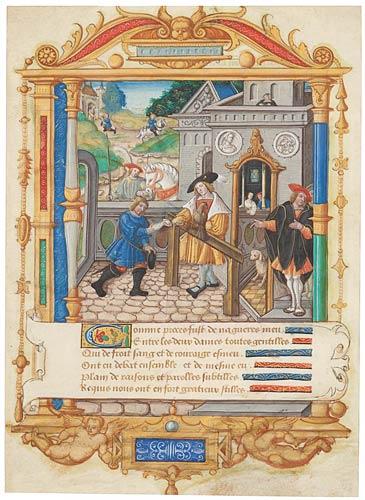
Single leaf from Guillaume Crétin, Debate on Hunting with Dogs and Birds, in French
Illuminated by the Master of François de Rohan
Purchased with a grant from the B.H. Breslauer Foundation, 2011
Hunting with Dogs Versus Birds
This miniature comes from the unique illuminated copy of Crétin's poem on hunting with dogs versus birds. Handing his decision to a messenger is the count of Tancarville, who was asked to settle the debate (dogs win). The nobleman wears a gown with a wide fur collar and slit sleeves hanging by his sides. Through these slits he extends the sleeves of his doublet, which, in the Italian fashion, are tight on the forearm but puffed at the biceps. His shoes are square-toed. The courtier to the right wears a black mantle and slashed square-toed shoes. Both he and the count wear new low-brimmed hats.
Dawn of the Renaissance
After the coronation of François I in 1515, a fundamental change came about in French art and culture. The king, known even during his lifetime as "father of the arts," was a connoisseur who imported major Italian artists (Leonardo da Vinci among the first) and artworks to France on a grand scale. Italian fashions, which began to appear during the reign of his predecessor, Louis XII, flowered under François.
For men, the long bulky gowns of the previous period disappeared, replaced by short ones with wide shoulders. Worn open and with short sleeves, the new gown showed off the slashed front and sleeves of Italianate doublets that offered sexy glimpses of the man's linen shirts. Low-brimmed hats, worn at jaunty angles, were decorated with slanted ostrich feathers. Shoes were square-toed, their uppers sometimes slashed.
Women, too, adopted Italian styles. Their gowns, featuring low, square necks, provided glimpses of their linen smocks. Sleeves also displayed the smock: these were now often worn loosely tied to the bodice or split into two parts and slit along the underside.
